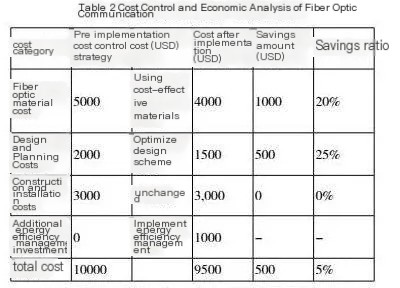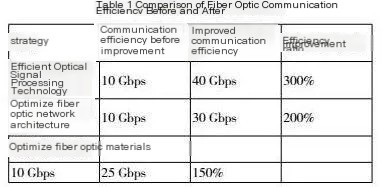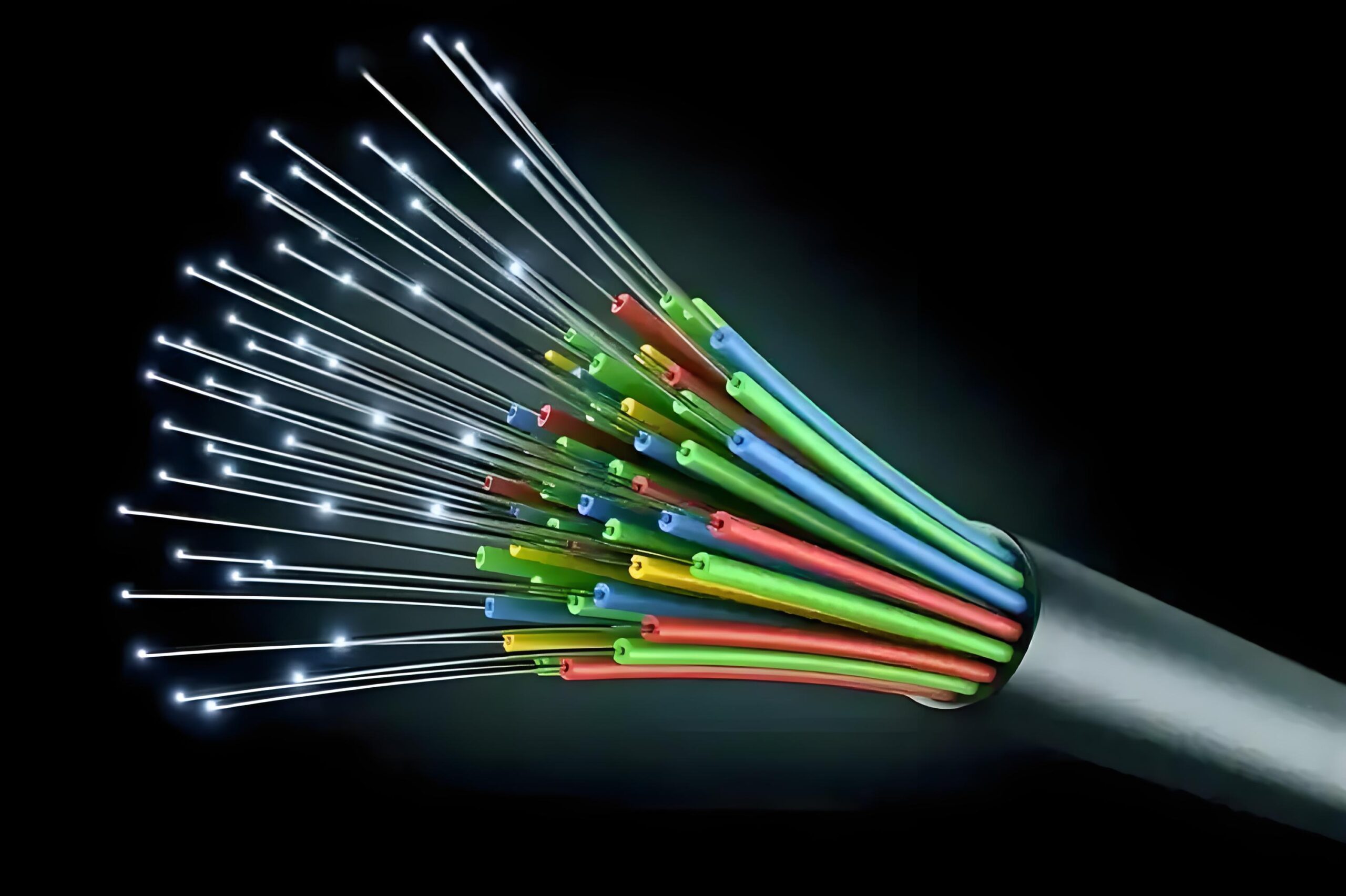Abstract: With the accelerated development of the information society, optical fiber communication technology, as an important means of information transmission, has attracted wide attention for its development status and future direction. This paper analyzes the development history of optical fiber communication technology and deeply explores its basic principles, key technologies and application status in multiple fields. At the same time, corresponding solutions are proposed for the main challenges and problems faced by optical fiber communication technology.
Since its birth, optical fiber communication technology has become a major breakthrough in the field of modern communications with its high speed, large capacity and strong anti-interference ability. Its application in data transmission and network construction has greatly promoted the development of the information society, not only promoting the sharing of global information resources, but also providing technical support for the development of economic globalization.
However, with the sharp increase in global data traffic and the continuous upgrading of communication needs, existing optical fiber communication technology faces unprecedented challenges. How to further improve the transmission rate, reduce energy consumption, and improve the reliability and security of the system is of great significance to promoting the progress of optical fiber communication technology and its applications.
I. Development history of optical fiber communication technology
1. Research and application of early optical fiber communication technology
Early research on fiber-optic communication technology focused on the improvement of fiber materials and the effective transmission of optical signals. Initially, the practical application of fiber-optic communication was greatly limited due to the high loss and signal attenuation problems inside the optical fiber. However, with the advancement of materials science, especially the breakthrough in pure silicon manufacturing technology, the loss rate of optical fiber has been significantly reduced.
At the same time, the development of laser light sources and the improvement of light detection technology laid the foundation for the early development of fiber-optic communication.
2. Rapid development stage of optical fiber communication technology
In the 1980s, with the maturity of optical fiber manufacturing technology and the advancement of optoelectronic conversion technology, optical fiber communication began to enter a rapid development stage. During this period, the emergence of wavelength division multiplexing (WDM) technology greatly improved the transmission capacity and efficiency of optical fiber communication systems.
By simultaneously transmitting optical signals of multiple wavelengths in the same optical fiber, full utilization of communication bandwidth is achieved. In addition, the invention of optical amplifiers enables optical signals to be amplified without being converted into electrical signals, greatly extending the distance of optical fiber communication and providing technical support for the construction of long-distance communication networks .
3. Current Development Status of Optical Fiber Communication Technology
At present, fiber-optic communication technology has entered a new stage of development. With the continuous advancement of information technology and the sharp increase in data demand, fiber-optic communication is facing the need for higher speed and greater capacity.
To this end, researchers and engineers are exploring more efficient transmission methods and more advanced fiber-optic technologies, such as multimode fiber technology and space division multiplexing technology. At the same time, with the popularization of fiber-to-the-home (FTTH) technology, fiber-optic communication technology has penetrated into people’s daily lives and provided high-speed Internet access services for individual users.
In addition, the exploration and application of quantum communication technology has opened up a new direction for the development of fiber-optic communication technology, indicating that communication technology will enter a new era.
II. Basic principles and key technologies of optical fiber communication technology
1. Basic structure and transmission principle of optical fiber
As the core medium of optical fiber communication, optical fiber has a simple and delicate structure, mainly composed of core, cladding and outer protective cover. The core is usually made of high-purity quartz glass, and its function is to transmit optical signals; the cladding surrounds the core and has a lower refractive index.
Its main function is to ensure that the optical signal can be effectively transmitted in the core without loss through the principle of total reflection; the outer protective cover is used to protect the optical fiber from the influence of the external environment. Optical fiber uses the difference in the refractive index of light between different media to achieve efficient transmission of optical signals through total internal reflection.
2. Generation, transmission and reception of optical signals
The generation of optical signals is the starting point of fiber-optic communication systems. In modern communication systems, the generation of optical signals usually relies on lasers or light-emitting diodes (LEDs), which can generate light waves with stable frequency and sufficient intensity.
These light waves are modulated by a modulator, carry information data, and are then injected into the optical fiber. In the process of optical fiber transmission, in order to ensure signal quality and extend the transmission distance, optical amplifiers are widely used to compensate for the losses in the transmission process.
After reaching the destination, the optical signal is converted into an electrical signal by an optical receiver such as a photodiode or an avalanche photodiode. In this process, the sensitivity and response speed of the receiver are crucial to the quality of signal restoration.
In order to improve the performance of the system, various signal processing techniques such as amplification, filtering, and error detection and correction are usually used at the receiving end to ensure that the received information is as accurate as possible.
3. Fiber Amplifier and Wavelength Division Multiplexing Technology
Fiber amplifier and wavelength division multiplexing (WDM) technology are two key technologies in the field of fiber optic communication. Together, they have promoted the development of communication systems towards higher speeds and larger capacities.
Fiber amplifiers, especially erbium-doped fiber amplifiers (EDFA), effectively solve the problem of signal attenuation by directly amplifying optical signals during transmission, greatly extending the transmission distance of optical signals without the need for electrical signal conversion, thereby maintaining the purity and transmission efficiency of the signal.
The application of this technology is of great significance to long-distance communications and submarine optical cable communication systems. Wavelength division multiplexing technology uses optical signals of different wavelengths to be transmitted simultaneously in the same optical fiber, similar to frequency division multiplexing in wireless communications, greatly increasing the data transmission capacity of a single optical fiber.
Wavelength division multiplexing technology is divided into dense wavelength division multiplexing (DWDM) and coarse wavelength division multiplexing (CWDM). Among them, DWDM is more suitable for high-capacity transmission because it can provide more wavelength channels in a very narrow frequency band.
The development of wavelength division multiplexing technology has not only improved the data transmission rate of optical fiber communication, but also effectively reduced costs and improved the flexibility and scalability of communication networks.
4. Error detection and correction technology for optical fiber communication
In optical fiber communication systems, ensuring the accuracy of transmitted data is crucial. Therefore, error detection and correction technology has become an indispensable part of system design. Forward error correction (FEC) technology is an error correction technology widely used in optical fiber communication.
It adds additional checksum information at the sending end, enabling the receiving end to detect and correct a certain number of errors, thereby improving the reliability of data transmission. This technology is particularly suitable for long-distance transmission and high-speed data communication. It can effectively reduce the bandwidth waste caused by error retransmission and ensure communication quality .
In addition, with the increasing complexity of optical fiber communication systems, adaptive equalization technology and digital signal processing (DSP) technology are also widely used in error detection and correction. These technologies can adjust system parameters in real time, optimize the signal transmission process, and further enhance the performance and stability of optical fiber communication systems.
III. Application fields of optical fiber communication technology
1. Application of optical fiber communication in data centers
As a core facility for processing and storing large amounts of data, data centers have extremely stringent requirements for communication technology. Among them, fiber-optic communication technology has become the preferred solution for connecting data centers and the outside world due to its high speed, large capacity and low latency.
Within the data center, fiber-optic connections are used to achieve high-speed data exchange between servers to ensure efficient and real-time data processing. When conducting large-scale data analysis and cloud computing services, fiber-optic communication can provide sufficient bandwidth to meet the needs of data transmission.
In addition, with the continuous expansion of the scale of data centers and the popularization of distributed architectures, connections between data centers are becoming increasingly important. Fiber-optic communication technology can provide high-speed connections across regions, allowing data centers in different locations to synchronize data in real time, ensuring data consistency and service continuity. The application of fiber-to-the-home (FTTH) technology has directly extended the services of data centers to end users, greatly improving user experience and promoting the development of the information society.
2. Long-distance optical fiber communication network
Long-distance fiber-optic communication network is another application field of fiber-optic communication technology. It connects information from different regions, countries and even continents at high speed, and is an important part of the global information infrastructure.
By using fiber amplifiers and wavelength division multiplexing technology, long-distance fiber-optic networks can achieve information transmission over thousands or even tens of thousands of kilometers without signal attenuation and information loss.
As an important communication link connecting different continents, the construction and maintenance of submarine cable systems demonstrate the maturity and reliability of long-distance fiber-optic communication technology. With the acceleration of globalization, information exchanges between countries are becoming more and more frequent, and the role of long-distance fiber-optic communication networks has become more important.
In addition, with the promotion of new-generation communication technologies such as 5G, the demand for high-speed and large-capacity communication networks has further increased. The construction and optimization of long-distance fiber-optic communication networks will undoubtedly play a more important role in the future development of communications.
3. Fiber Optic Solutions for Metropolitan Area Networks and Access Networks
With the rapid development of Internet technology, metropolitan area networks and access networks, as important links connecting users with data centers or Internet resources, have put forward higher requirements for communication technology.
Optical fiber communication technology, with its high speed and large capacity, provides an ideal solution for metropolitan area networks and access networks. By deploying optical fiber networks, metropolitan area networks can achieve efficient data transmission and rapid service response, supporting various information services within the city, such as intelligent monitoring, traffic management, and public safety .
In the field of access networks, fiber-to-the-home (FTTH) technology has become one of the key technologies for improving the quality of network services. By extending optical fiber directly to users’ homes, FTTH not only significantly increases the bandwidth of the network, meeting the needs of broadband-intensive applications such as high-definition video streaming and online games, but also greatly reduces network latency and improves user experience.
In addition, with the deployment of 5G networks, optical fiber networks play an irreplaceable role in providing stable backhaul links, ensuring the high speed and low latency characteristics of 5G networks can be realized.
4.Application of optical fiber communication in special environments
Due to its unique physical properties, optical fiber communication technology has incomparable advantages in special environments. In environments with high electromagnetic interference, such as industrial production lines and power stations, optical fiber communication is not affected by electromagnetic interference and can ensure the stability of communication and the accuracy of data transmission, making it an ideal communication method in these environments.
At the same time, in the fields of oil and gas pipeline monitoring and seabed detection that require long-distance data transmission, optical fiber communication has shown great application potential with its long-distance transmission and high reliability.
5. Strategies to improve the efficiency of optical fiber communication
At present, in the field of communication technology, improving the efficiency of optical fiber communication is the key to achieving faster and more reliable network communication. To meet this challenge, the following strategies can be adopted:
First, adopt advanced modulation technology. With the advancement of technology, more complex modulation technologies, such as phase modulation and orthogonal amplitude modulation, are used to increase the data transmission rate of each optical carrier. These advanced modulation technologies can effectively improve the bandwidth utilization of optical fiber communication by transmitting more information in the same frequency band.
Second, optimize the intelligent routing of optical fiber networks. By deploying a more intelligent network management system, dynamic routing of data streams can be achieved, network congestion can be reduced, and data transmission delay can be reduced. Intelligent routing algorithms can adjust data transmission paths in real time according to network status to ensure that data is transmitted with the highest efficiency.
Third, deploy more efficient optical fiber amplifiers. In order to extend the signal transmission distance while reducing signal attenuation, the use of more efficient optical fiber amplifiers is an effective strategy. By deploying amplifiers at appropriate locations in the transmission link, the signal quality and transmission stability of long-distance communication can be effectively improved. Fourth, use wavelength division multiplexing (WDM).
WDM technology improves the data transmission capacity of communication lines by transmitting multiple signals of different wavelengths in the same optical fiber . This technology not only significantly increases the data transmission volume of a single optical fiber, but also improves the overall efficiency and scalability of the network. The expected effects after adopting relevant strategies are shown in Table 1.




IV. Cost Control and Economic Analysis of Optical Fiber Communication
Cost control is essential for the sustainable development of fiber-optic communication projects. Here are several effective cost control strategies:
First, optimize the fiber-optic network design. By accurately planning the fiber-optic network layout, the length and number of required optical fibers can be minimized, and the material and construction costs can be reduced. At the same time, reasonable network design can also reduce future maintenance costs and network upgrade costs.
Second, use cost-effective fiber-optic materials. Selecting cost-effective fiber-optic materials is critical to controlling the initial investment of the project. Through market research and technical comparison, selecting fiber-optic materials that can meet performance requirements and are economical can effectively control project costs.
Third, implement energy-saving measures. In fiber-optic communication systems, taking energy-saving measures and reducing energy consumption are crucial to reducing operating costs. By optimizing equipment configuration, using more efficient optoelectronic conversion equipment, and adopting intelligent power management systems, power consumption can be significantly reduced.
Fourth, technological innovation and cooperative sharing. Through technological innovation, the manufacturing cost of fiber-optic communication equipment can be reduced. At the same time, sharing fiber-optic network infrastructure with other operators can share investment costs and maximize economic benefits. Taking a 1,000-meter fiber project as an example, the expected cost-effectiveness after taking cost control measures is shown in Table 2.
It can be seen from the data in the table that in the cost control strategy, the optimized design scheme can bring greater cost savings, which shows that cost-effectiveness should be considered in the project planning and design stage to achieve the optimal balance between economy and technology
V. Conclusion
The progress of fiber-optic communication technology not only demonstrates mankind’s unremitting pursuit of high-speed and efficient communications, but also reflects the core role of scientific and technological innovation in promoting social progress.
The development of fiber-optic communication technology is a vivid example of the mutual promotion of scientific exploration and technological application, and provides a solid foundation for the construction of the global information network.
With the continuous emergence of new technologies, fiber-optic communication will continue to lead the innovation in the field of communications, stimulate broader social changes, and promote human society towards a more interconnected, efficient, and intelligent future.


